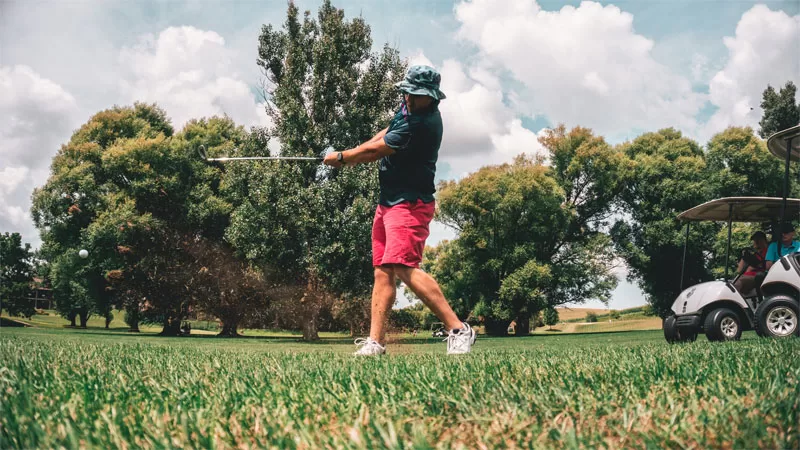
Unlike many other sports, golf requires a unique blend of physical skill, mental focus, and strategic thinking. Consistent practice for beginner golfers improves their technical skills but also enhances their understanding and enjoyment of the game.
The Role of Practice in Skill Development
The development of golf skills heavily relies on muscle memory and repetition. Muscle memory allows golfers to perform complex swing mechanics consistently. This consistency is crucial in golf, where even minor deviations can significantly affect the outcome of a shot. Regular practice sessions reinforce these movements, helping beginners develop the necessary muscle memory to execute their swings effectively.
Regular practice also offers mental advantages. It helps build confidence, reduces anxiety, and prepares golfers for various on-course scenarios. Practicing different shots and situations can make beginners more adaptable and better prepared to handle the challenges of a round of golf.
Golf Swing Basics
A proper golf swing is the foundation of a good golf game. An effective golf swing involves several key elements that beginners need to master. The grip is fundamental; the way you hold the club has a significant impact on your swing. Beginners should learn the correct grip, whether it’s the overlapping, interlocking, or ten-finger grip.
Proper stance and posture are crucial for balance and power, with feet shoulder-width apart, knees slightly bent, and weight evenly distributed. The backswing should be smooth and controlled, ensuring the club moves along the correct path while maintaining a steady head position and avoiding any lifting or swaying.
The downswing is initiated by the lower body, with the hips rotating towards the target. Maintaining a strong wrist position through impact is essential for solid contact with the ball.

A complete follow-through, with the body facing the target and the club finishing high, is vital for maximizing power and accuracy.
Tips for Beginners
- Start Slow: Focus on mastering the basics before attempting more advanced techniques. Practicing slow, deliberate swings can help beginners understand the mechanics and develop consistency.
- Use Training Aids: Tools like alignment sticks, weighted clubs, and swing trainers can provide valuable feedback and help correct common mistakes.
- Take Lessons: Working with a golf instructor can provide personalized guidance and ensure that beginners are practicing correctly.
- Practice Regularly: Consistency is key. Regular practice sessions, even if short, can significantly improve a beginner’s swing over time.
- Video Analysis: Recording swings and reviewing them can help identify areas for improvement and track progress.
By focusing on these basics and incorporating these tips into their practice routine, beginners can develop a solid, consistent golf swing, setting the stage for continued improvement and enjoyment of the game.
The Importance of Practice for Beginner Golfers
Short Game Practice
The short game is a critical component of golf, often accounting for the majority of strokes in a round. For beginners, focusing on chipping, pitching, and putting is essential for lowering scores and gaining confidence in the course. Practicing these skills helps golfers navigate various on-course situations, from tricky greenside lies to long putts.
Chipping: Chipping involves short, controlled shots designed to get the ball in the air and rolling towards the hole. To improve chipping:
- Use a consistent setup: Keep your weight forward, hands ahead of the ball, and use a narrow stance.
- Control the loft: Practice with different clubs to understand how the loft affects the roll-out of the ball.
- Focus on contact: Ensure clean contact by hitting down on the ball, and avoiding scooping.

Pitching: Pitching requires more loft and a higher trajectory than chipping. Key techniques include:
- Open your stance: Position your feet slightly open to the target line.
- Maintain wrist hinge: Keep a firm wrist hinge through the swing to control the distance and trajectory.
- Use a smooth tempo: A consistent, smooth tempo helps with accuracy and distance control.
Putting: Putting can make or break your score, and mastering it is crucial:
- Develop a routine: A consistent pre-putt routine builds confidence and focus.
- Practice distance control: Work on lag putting to avoid three-putts by getting the ball close to the hole from long distances.
- Focus on alignment: Use alignment aids to ensure your putter face is square to the target line.
Creating a Practice Routine
A structured practice routine is essential for efficient improvement. Here’s how beginners can balance their practice sessions:
Structuring Practice Sessions
- Warm-Up: Begin with stretching and light exercises to prepare your body.
- Allocate Time: Divide your practice time between the long game, short game, and mental practice. Spend 30% of your time on the driving range, 40% on the short game area, and 30% on putting and mental exercises.
- Set Goals: Establish specific goals for each session, such as improving chipping accuracy or increasing driving distance.
Balancing Practice
- Long Game: Focus on driving and long iron shots to build consistency and power.
- Short Game: Allocate significant time to chipping, pitching, and putting as these shots often determine your score.
- Mental Game: Practice visualization and mental toughness exercises to prepare for on-course pressure.
Utilizing Training Aids and Technology
Training aids and technology can accelerate improvement by providing feedback and simulating real-game conditions.
Useful Training Aids
- Alignment Sticks: Help with proper alignment and swing path.
- Weighted Clubs: Build strength and improve swing mechanics.
- Putting Mats: Allow for at-home practice to refine putting skills.
Role of Technology
- Golf Simulators: Offer realistic course simulations and provide data on swing mechanics, ball flight, and club performance.
- Swing Analyzers: Attach to clubs to give real-time feedback on swing speed, path, and impact position.
- Mobile Apps: Track progress, set practice goals, and provide instructional videos.
By incorporating these elements into their practice for beginner golfers can develop their skills more efficiently and enjoy the game of golf to its fullest.
Mental Practice and Visualization
In golf, the mental game is just as important as the physical game. Mental practice and visualization can significantly enhance a beginner’s performance by building confidence, reducing anxiety, and improving focus.

Visualization Techniques
- Imaginary Rehearsal: Before taking a shot, close your eyes and imagine a successful outcome. Picture the ball’s trajectory, the swing, and the ball landing where you intend.
- Positive Thinking: Replace negative thoughts with positive affirmations. Visualize past successes to build confidence.
- Routine Development: Establish a pre-shot routine that includes a moment of visualization. This helps in creating a calm and focused state of mind.
Mental Toughness
- Stay in the Present: Focus on the current shot rather than dwelling on past mistakes or worrying about future ones.
- Breathing Exercises: Use deep breathing techniques to stay calm and centered under pressure.
- Goal Setting: Set realistic and achievable goals for each practice session and round. This keeps you motivated and focused on improvement.
Tracking Progress and Setting Goals
Tracking progress and setting goals are essential components of effective practice. They provide direction, measure improvement, and maintain motivation.
Methods for Tracking Progress
- Practice Journal: Keep a journal to record the details of each practice session, including what you worked on, how you felt, and any notable improvements or challenges.
- Video Analysis: Regularly record your swings and compare them over time. This visual feedback helps identify areas for improvement and track progress.
- Performance Metrics: Use statistical analysis to track key performance indicators such as fairways hit, greens in regulation, and putting averages.
Setting Goals
- Short-Term Goals: Set achievable goals for each practice session or week, such as improving your chipping accuracy or hitting a specific number of fairways.
- Long-Term Goals: Establish broader goals for the season or year, such as lowering your handicap or mastering a particular aspect of the game.
- SMART Goals: Ensure your goals are Specific, Measurable, Achievable, Relevant, and Time-bound. This framework helps in creating clear and attainable objectives.
Takeaway
Practice for beginner golfers is crucial to improve their golf skills and enjoy the game more. Beginners can develop a well-rounded practice routine that addresses all aspects of the game if they stay committed to their practice, set realistic goals, and embrace the journey of continuous improvement in golf. If you’re in need of a reliable golf cart to make your time on the course more enjoyable, be sure to check out https://golfcartsofatx.com/.
Leave a Reply